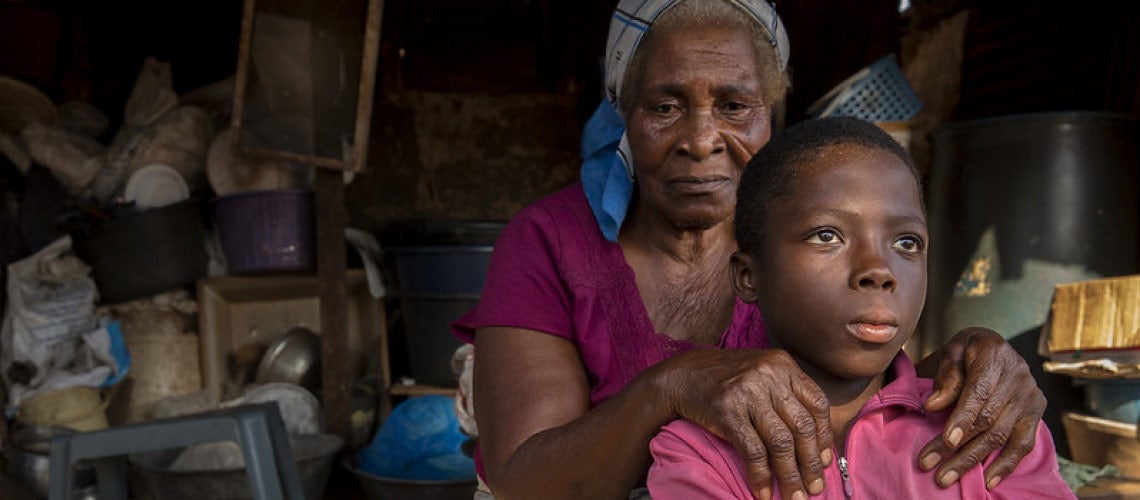 Ester Awo Bartey et son petit-fils sont tous deux bénéficiaires du programme Revenu de subsistance contre la pauvreté (LEAP) au Ghana. Photo : Dominic Chavez / Banque mondiale
Ester Awo Bartey et son petit-fils sont tous deux bénéficiaires du programme Revenu de subsistance contre la pauvreté (LEAP) au Ghana. Photo : Dominic Chavez / Banque mondiale
No part of the world is untouched by the coronavirus (COVID-19) – directly or indirectly – and social protection systems are crucial to safeguarding the poor and vulnerable when crises hit. Already, 126 countries have introduced or adapted social protection and labor market policies in response to COVID-19, with 505 measures currently in place. Yet, in many parts of the world, programs’ coverage remains limited – especially where it’s needed most. As countries roll out measures to mitigate the impact of the pandemic, let me propose three social protection measures—two in the immediate term, and one in the medium term— to ensure that no one is left behind by this unprecedented crisis.
First, provide social assistance to help societies get through the pandemic. Quarantines, the shutdown of non-essential businesses, higher prices for food and basic goods with more limited access to them, as well as higher medical costs are adversely affecting millions of people.
For countries where the virus is already prevalent, it is critical to expand social safety nets so that they quickly disburse more or larger cash transfers to new and existing beneficiaries. Currently, there are 130 new cash initiatives that have been introduced as COVID-19 responses. The Philippines, for example, has introduced five new cash programs alongside its national Pantawid program.
Countries also need to extend social safety nets to certain at-risk groups, including those in affected employment sectors, such as tourism, with payment to compensate for loss of income. For example, income support in the form of childcare vouchers or allowances are being provided in Italy and South Korea. Other social assistance programs include support for homeless populations, as planned in Spain; subsidies that let utilities waive fees for basic services, as in El Salvador; waivers for loans and other financial obligations, as in Bolivia; and COVID19-sensitive public works, which are being tested in the Philippines.
The World Bank Group has mobilized quickly to make up to $160 billion available over the next 15 months for key COVID-19 interventions in the world’s poorest countries. In Pakistan, we are providing $25 million in emergency cash transfers for up to 4 million people under the national safety net, the Benazir Income Support Program (BISP). This additional assistance to the poorest will help prevent negative coping strategies, such as reducing food consumption or selling vital assets, and help protect human capital. A further $12 million will finance delivery of basic food supplies to 40,000 persons who are quarantined or have limited mobility for a period of 6 months. In Tajikistan, the existing Targeted Social Assistance system will provide time-bound cash transfers to food-insecure households with children under age 2; this will help mitigate the effects of higher food prices and protect children’s nutrition.
Second, preserve livelihoods through employment retention or restoration. We estimate a significant rise in unemployment and underemployment as a result of COVID-19. Meanwhile, private sector analysts are already predicting much greater output and employment shocks without powerful policy responses.
To help mitigate these risks in the short term, governments can provide one-off grants to allow small businesses to survive or be restored post-crisis, as well as subsidies to private sector firms to minimize layoffs. The Korean government, for example, will finance subsidies of up to two-thirds of wages to help employers retain workers during sharp declines of revenues or increases in inventory owing to the outbreak; this is capped at US$66 per employee, per day. Malaysia is taking a different approach to job creation in tourism and other affected sectors, by providing up to RM100 million (around US$23 milion) to the Human Resource Development Fund on a matching grant basis. This will fund an additional 40,000 employees.
Third, shore up social protection systems to ensure preparedness for future crises. Once the pandemic wanes, governments should waste no time in enhancing existing social safety net systems to make them more responsive to shocks in the future. This means improving delivery systems so that social protection programs can reach the vulnerable more quickly, efficiently, and transparently, with the ability to scale up in times of crisis. It also means focusing on building resilience through economic inclusion programs.
The World Bank has helped low-income countries across the world develop their social safety nets and make them more shock-responsive, so that they are better prepared for crises. For example, the Bank has supported Mauritania in developing both the Tekavoul cash transfer program for the chronic poor, as well as the Elmaouna shock-response program, which provides seasonal cash transfers on a small scale. These kinds of systems can be scaled up during crises and adjusted to meet new needs.
An ounce of prevention is worth a pound of cure, as the saying goes. Putting in place social protection systems that can respond to an emergency efficiently and at scale will help manage the devastating effects of the largest pandemic of our lifetime.


Join the Conversation